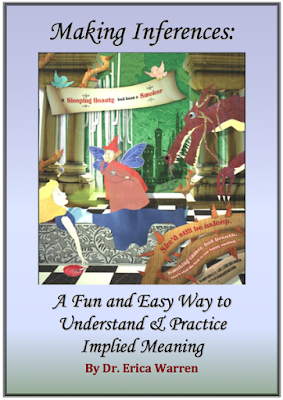9 Terrific Ways to Teach Inferences and Have Fun
Posted by Erica Warren on
Inferences or implied meanings are often subtle, hidden messages that can be challenging for many young learners to recognize and understand. They require abstract reasoning skills, and for concrete learners, inferences can seem quite perplexing. Most students first encounter inferences when discussing their readings, but I like to pave the way and introduce these ideas through images, metaphors, product names, games, and other engaging materials.

1) Review Magazine Advertisements
- Lesson: Project magazine ads and ask your students to search for hidden images and messages that entice buyers to purchase the products. Look at the pictures, words, colors, backgrounds, symbols, layouts, and more.
- Group activity: Encourage your students to find their own advertisements from magazines and newspapers. Ask them to cut out their three favorites and answer the following questions. What are all the hidden messages in each advertisement that help to sell the product? Can you think of any other hidden message that they could have placed into the ad to help sell the product? Ask them to present their findings to the class.
- Homework assignment: Ask your students to create their own magazine advertisement for a real or imaginary product. It can be a collage or a drawing. Ask them to consider using color, words, symbols, backgrounds, and other implied tactics to get people to purchase the product.
2) Analyze Television Commercials
- Lesson: Show TV advertisements (many compilations are available on YouTube) to your students and uncover any double meanings or hidden messages. Ask them questions like: What are they trying to sell you? Why does the commercial make you want to buy the product? What are all the different ways commercials attract customers?
- Group assignment: In small groups, ask students to plan and act out a television commercial for a specific product. Ask them to hide at least 4 inferences or hidden meanings in the commercial. Have them present their TV ad to the class, and see if the rest of the class can find all the inferences.
3) Billboards
- Lesson: Look at details in billboard images and discuss what the billboards are trying to communicate/sell. What kinds of inferences, or hidden messages, are in the image?
- Homework assignment: Ask your students to create their own billboard to sell a real or imaginary product or movie. Ask them to consider using color, expressions, symbols, backgrounds, and other implied tactics to get the public's attention. Ask them to make a list of all the inferences they included in their image.

4) Product names and packaging
- Lesson: Products offer inferences or hidden meanings, too. Bring in some popular products and talk about what is implied by the name and the packaging.
- Homework assignment: Ask your students to create their own product and to come up with a catchy name. Ask them to consider using color, expressions, symbols, backgrounds, and other implied methods to get people to buy their product. Ask them to make a list of all the ways they used inferences to help sell their product.
Ready-Made Workbook of Inference Activities:

If you love these ideas, let me do the work for you! I spent over a year collecting some amazing images for you, as well as creating inference activities and a really fun game. Come learn more about my 60-page product, Making Inferences: The Fun and Easy Way. You can even download a free sampling of activities!
You can also get a digital version of this publication in my executive functioning library of resources. Click here to learn more.
I hope this helps. Reach out any time.
Cheers, Erica
Dr. Erica Warren is the author, illustrator, and publisher of multisensory educational materials at Good Sensory Learning. She is also the director of Learning to Learn and Learning Specialist Courses.
- Blog: https://goodsensorylearning.com/blogs/news
- YouTube Channel: https://www.youtube.com/user/warrenerica1
- Executive Function Podcast: https://goodsensorylearning.com/pages/the-personal-brain-trainer-podcast-with-dr-erica-warren
- Store: http://www.Goodsensorylearning.com/
- Courses: http://www.learningspecialistcourses.com/
- Newsletter Sign-up: https://good-sensory-learning.kit.com/drericawarren

